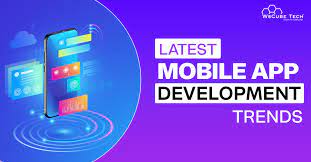In the ever-evolving landscape of mobile app development in the USA, staying ahead of the curve is essential. Developers should focus on cross-platform development to maximize efficiency and reduce costs while ensuring user-centric design to create engaging and intuitive interfaces. The integration of emerging technologies like 5G, AI, and AR/VR can provide unique and immersive experiences, setting apps apart from the competition.
Security and data privacy remain paramount, with strict adherence to regulatory standards. IoT integration and sustainability considerations are increasingly relevant, as the world becomes more interconnected and environmentally conscious.
App Store Optimization (ASO) plays a critical role in boosting app visibility and downloads. Lastly, the commitment to continuous learning and networking within the developer community is key to staying informed about the latest trends and technologies. By following these tips and embracing current trends, developers can create successful and impactful mobile apps in the dynamic USA market.
Exploring the Latest Trends in Mobile App Development

Mobile app development is a rapidly evolving field, with trends that shape the industry and impact user experiences. Here, we delve into the latest trends driving innovation in mobile app development:
5G Integration:
The rollout of 5G networks has opened up new possibilities for mobile apps, offering faster speeds and lower latency. This trend enables real-time streaming, augmented reality experiences, and smoother app interactions.
Business Applications: Enterprises can benefit from 5G by improving remote work capabilities, enhancing video conferencing quality, and enabling faster data transfer for business-critical applications.
Efficient Cloud Services: Cloud-based apps can leverage 5G for faster access to cloud resources, making data-intensive tasks more efficient and reducing reliance on local device storage.
Location-Based Services: Apps that rely on precise location data, such as ride-sharing and navigation apps, can provide more accurate and real-time information to users.
AI and Machine Learning:
AI-driven apps are becoming increasingly prevalent. Developers leverage machine learning algorithms to offer personalized content recommendations, chatbots for customer support, and predictive analytics for enhanced user engagement.
Improved Decision-Making: Machine learning algorithms analyze data to make data-driven decisions, aiding businesses in making informed choices and strategies.
Efficiency: Automation and optimization of processes lead to increased efficiency and cost savings in various industries.
Customer Service: Chatbots and virtual assistants powered by AI provide efficient and round-the-clock customer support, enhancing user experiences.
Cross-Platform Development:
Cross-platform frameworks like React Native, Flutter, and Xamarin continue to gain popularity. They allow developers to write code once and deploy it on multiple platforms, reducing development time and costs.
Community and Support: Popular cross-platform frameworks like React Native and Flutter have active communities and extensive documentation, making it easier to find solutions to common issues.
Rapid Prototyping: Cross-platform development is ideal for rapid prototyping and testing app ideas before committing to a specific platform.
Cost-Effective Updates: Rolling out updates simultaneously across all platforms is more cost-effective than updating native apps separately.
Augmented Reality (AR) and Virtual Reality (VR):
AR and VR technologies are transforming various industries. Apps incorporating AR and VR provide immersive experiences in gaming, e-commerce, education, and training.
Augmented Reality (AR) Benefits :
Enhanced User Experience: AR overlays digital information onto the real world, enriching user experiences by providing context-relevant data and interactions.
Real-Time Information: AR apps can display real-time data, such as navigation directions, product details, or live sports scores, improving decision-making and convenience.
Virtual Reality (VR) Benefits :
Immersive Simulations: VR offers highly immersive simulations for training, education, and skill development in various industries, including healthcare and aviation.
Therapeutic Applications: VR is used for therapeutic purposes, such as treating phobias, PTSD, and pain management, providing an alternative to traditional therapies.
Enhanced Security:
With increased concerns about data privacy, app security remains a top priority. Developers implement robust encryption, and secure authentication methods, and regularly update security features.
Data Protection: Enhanced security safeguards sensitive data, protecting it from unauthorized access, breaches, and data leaks.
Customer Trust: Robust security measures build trust with customers, assuring them that their personal and financial information is safe when using digital services.
Business Reputation: A reputation for strong security practices can enhance a company’s brand image, making it more attractive to customers and partners.
App Store Optimization (ASO):
ASO strategies, including keyword optimization, engaging visuals, and user reviews, are vital for app discoverability and downloads.
Improved Visibility: ASO techniques increase an app’s visibility within app stores, making it more likely to appear in search results and top charts, which can lead to higher organic downloads.
Increased Downloads: When an app ranks higher in search results and is featured in top charts, it attracts more organic downloads, reducing the need for costly user acquisition campaigns.
Enhanced User Engagement: ASO focuses on optimizing app listings, including the app’s title, description, and visuals, resulting in clearer and more appealing communication with potential users. This can lead to higher engagement and conversions.
Low-Code/No-Code Development:
These platforms empower individuals with minimal coding experience to create functional apps using visual interfaces, expediting app development.
Rapid Development: Low-code/no-code platforms enable the creation of applications in significantly less time compared to traditional coding, accelerating time-to-market.
Reduced Development Costs: With fewer resources required for development, including skilled developers, cost savings are realized in both personnel and infrastructure.
Accessible to Non-Developers: Non-technical users, such as business analysts and subject-matter experts, can participate in app development, reducing the dependency on IT departments.
Progressive Web Apps (PWAs):
PWAs offer the benefits of both web and mobile apps, providing offline access, push notifications, and responsive design.
Benefits for Users:
Cross-Platform Compatibility: PWAs work on various platforms and devices, providing a consistent user experience whether accessed on desktops, smartphones, or tablets.
Offline Access: PWAs can function offline or in low-network conditions, allowing users to access content and perform tasks even when an internet connection is unreliable or unavailable.
Fast Loading: PWAs are designed for quick loading, reducing the waiting time for users and improving overall site performance.
Five Essential Tips for Successful Mobile App Development

- Define Clear Objectives: Start by clearly defining the purpose and objectives of your mobile app. Understand your target audience, their needs, and the problems your app will solve. Having a well-defined vision sets the direction for the entire development process.
- User-Centered Design: Prioritize user experience (UX) and user interface (UI) design. Create intuitive, user-friendly interfaces that make navigation and interaction seamless. User testing and feedback should be ongoing throughout development to ensure the app meets user expectations.
- Choose the Right Technology Stack: Select the appropriate development tools, frameworks, and programming languages based on your app’s requirements. Consider factors like platform (iOS, Android, or cross-platform), scalability, and performance.
- Agile Development: Adopt agile development methodologies like Scrum or Kanban to enable flexibility and responsiveness to changing requirements. Break the project into manageable iterations, allowing for regular testing, feedback, and adjustments.
- Thorough Testing and Quality Assurance: Rigorous testing is essential to identify and resolve bugs and issues. Conduct functional, usability, performance, and security testing to ensure your app functions flawlessly and provides a secure user experience.
These tips form a solid foundation for successful mobile app development, helping you create a valuable, user-centric app that meets your business goals and user needs.
FAQ’S
- What are the key trends in mobile app development for 2023?
- Some key trends include the rise of 5G technology, AI and machine learning integration, cross-platform development, augmented reality (AR) and virtual reality (VR) applications, and a focus on sustainable and eco-friendly app development.
- How can I ensure my mobile app is user-centred?
- To create a user-centred app, start by understanding your target audience’s needs and preferences. Conduct user research, gather feedback, and prioritize user experience (UX) design. Regularly test your app with real users to refine its usability.
- What are the benefits of cross-platform development for mobile apps?
- Cross-platform development offers cost-efficiency, faster development, wider audience reach, consistent user experiences, and the ability to share code between different platforms like iOS and Android.
- How can I keep my mobile app secure in a rapidly evolving digital landscape?
- Ensure your app follows best practices for security, including data encryption, authentication mechanisms, and regular security audits. Stay updated on security trends and vulnerabilities to proactively address potential threats.
- What is App Store Optimization (ASO), and why is it important?
- ASO is the process of optimizing your app’s listing in app stores to improve its visibility and discoverability. It’s crucial for attracting organic downloads and ensuring your app ranks well in app store search results.

















